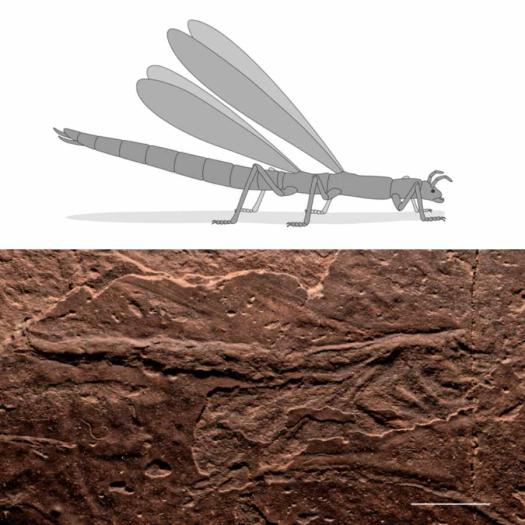A twig-like insect stuck in the Permian mud indicates early origin of an ecological strategy in Hexapoda evolution

Phasmichnus radagasti « la trace de Phasme de Radagast » - photo © R. Garrouste MNHN, illustration : © C. Garrouste

Phasmichnus radagasti « la trace de Phasme de Radagast » - photo © R. Garrouste MNHN, illustration : © C. Garrouste
A team of researchers from CR2P and ISYEB has just described a 265 million year old fossil record of a stick insect. These insects, most often mimetic by their elongated shape imitating branches or leaves, are the largest forms of insects known today (up to 50 cm for a Borneo species).
Full body impressions and resting traces of Hexapoda can be of extreme importance because they bring crucial information on behavior and locomotion of the trace makers, and help to better define trophic relationships with other organisms (predators or preys). However, these ichnofossils are much rarer than trackways, especially for winged insects. Here we describe a new full-body impression of a winged insect from the Middle Permian of Gonfaron (Var, France) whose preservation is exceptional. The elongate body with short prothorax and legs and long wings overlapping the body might suggests a plant mimicry as for some extant stick insects. These innovations are probably in relation with an increasing predation pressure by terrestrial vertebrates, whose trackways are abundant in the same layers. This discovery would possibly support the recent age estimates for the appearance of phasmatodean-like stick insects, nearly 30 million years older than the previous putative records. The new exquisite specimen is fossilized on a slab with weak ripple-marks, suggesting the action of microbial mats favoring the preservation of its delicate structures. Further prospections in sites with this type of preservation could enrich our understanding of early evolutionary history of insects.
Pour lire la publication : https://www.nature.com/articles/s41598-021-00110-2
Bibliography: Logghe, A., Nel, A., Steyer, JS. et al. A twig-like insect stuck in the Permian mud indicates early origin of an ecological strategy in Hexapoda evolution. Sci Rep 11, 20774 (2021). https://doi.org/10.1038/s41598-021-00110-2